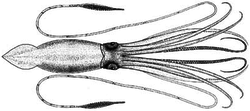Giant squid
| Giant squid | |
|---|---|
 |
|
| Giant squid, Architeuthis sp., modified from an illustration by A.E. Verrill, 1880 | |
| Scientific classification | |
| Kingdom: | Animalia |
| Phylum: | Mollusca |
| Class: | Cephalopoda |
| Subclass: | Coleoidea |
| Order: | Teuthida |
| Suborder: | Oegopsina |
| Family: |
Architeuthidae Pfeffer, 1900 |
| Genus: |
Architeuthis Steenstrup in Harting, 1860 |
| Species | |
probable synonyms:
|
|
 |
|
| Worldwide giant squid distribution based on recovered specimens | |
| Synonyms | |
|
|
probable synonyms:
The giant squid (genus Architeuthis) is a deep-ocean dwelling squid in the family Architeuthidae. Giant squid can grow to a tremendous size due to deep-sea gigantism: recent estimates put the maximum size at 13 m (43 ft) for females and 10 m (33 ft) for males from the posterior fins to the tip of the two long tentacles (second only to the colossal squid at an estimated 14 m (46 ft), one of the largest living organisms). The mantle is about 2 m (6.6 ft) long (more for females, less for males), and the length of the squid excluding its tentacles (but including head and arms) rarely exceeds 5 m (16 ft). Claims of specimens measuring 20 m (66 ft) or more have not been scientifically documented.
The number of different giant squid species has been debated, but recent genetic research suggests that only one species exists.
In 2004 Japanese researchers took the first images of a live giant squid in its natural habitat, and in July 2012 a live adult was first filmed in its natural habitat off Chichi-jima.
Like all squid, a giant squid has a mantle (torso), eight arms, and two longer tentacles (the longest known tentacles of any cephalopod). The arms and tentacles account for much of the squid's great length, making it much lighter than its chief predator, the sperm whale. Scientifically documented specimens have masses of hundreds, rather than thousands, of kilograms.
The inside surfaces of the arms and tentacles are lined with hundreds of subspherical suction cups, 2 to 5 cm (0.79 to 1.97 in) in diameter, each mounted on a stalk. The circumference of these suckers is lined with sharp, finely serrated rings of chitin. The perforation of these teeth and the suction of the cups serve to attach the squid to its prey. It is common to find circular scars from the suckers on or close to the head of sperm whales that have attacked giant squid.
...
Wikipedia

